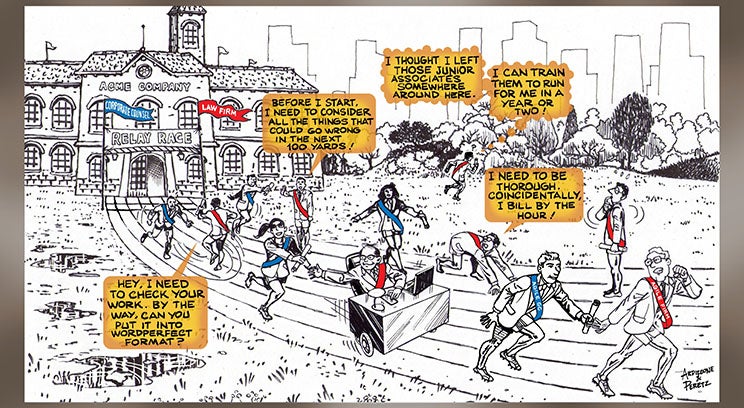
Emails at all hours of the day and night. Video conferences from every room in the house (and every car in the garage). Slack messages from your product and sales teams across multiple channels and times zones. Business is moving faster than ever before and your team needs to keep pace in order to support your internal clients. How do you do that when your law firm is moving at the speed of the Pony Express? It’s time to borrow a playbook from your tech team.
Software development was historically characterized by multi-year launch efforts that required many disparate pieces to all come together at the end. The result was often an expensive, long-delayed failure. And even if the effort produced a shippable product, intervening market changes often made the product obsolete by the time it was delivered. Insufficient speed and responsiveness to changing product demands resulted in suboptimal outcomes.
The same problems confront law departments and law firms. Teams are largely comprised of individual contributors who disappear behind closed doors to prepare lengthy memos that escalate through rounds of edits and approvals. The process can take weeks or months before critical feedback flows back to the business. And, as the technology industry discovered, even complete results often prove useless if business needs have shifted.
Why is this problem endemic to lawyers? Because we are trained to be zealous advocates and leave no stone unturned. What else would you expect from a profession whose education includes the intense study of a voluminous book of picayune topics like footnote formatting and preferred forms of abbreviation?
Tech teams have developed a methodology to provide quality results that are a better fit with evolving customer needs and delivered at a much faster clip. If you work in tech, you’ve probably heard of it: agile development. It’s taught at Harvard, Stanford, and other top business schools. NPR uses agile methods to create new programming. John Deere uses them to develop farm equipment, and Saab to produce fighter jets. Your law department should consider an agile approach as well.
Key principles of the agile method
At their heart, agile methodologies emphasize responsiveness and accountability. An agile project breaks down work into smaller increments and more frequent feedback loops. This approach yields the ability to more quickly spot when a project is falling off track, and the opportunity to more rapidly adjust course to meet new client requirements and market developments.
Aspects of the original Agile Manifesto may be a shock to lawyers when they read statements like “Customer collaboration over contract negotiation” and “Working software over comprehensive documentation.” Lawyers love contract negotiation and comprehensive documentation! The spirit of those statements, however, can be readily and effectively applied to produce better legal deliverables, faster.
[Related: Mindful Collaboration: 5 Factors to Meet Changing Legal Department Demands]
Consider the agile concept of “Customer collaboration over contract negotiation.” At its heart, the concept is not an affront to legal contracts. Rather, the notion is to elevate business goals over procedural gamesmanship. Lawyers often become mired in contractual clauses that drive dubious value at the expense of clearly understanding deliverables and expectations. The failure to properly appreciate business expectations determines success or failure more often than whether Delaware or New York law applies or whether venue is in Westchester County or Manhattan.
What does the agile approach of “Working software over comprehensive documentation” mean in the legal context? Think back to those prolix 18-page memoranda from your law firm that cost a small fortune and arrive too late. A summary email containing the predicted result is often more effective in the short term, as it provides operational guidance faster and facilitates a client discussion that may be quickly adjusted, as needed.
Your goal is to provide timely guidance to keep the process moving, not to bill the most hours. This does not mean that a more detailed study of the topic is unnecessary. You can flag the risks and mention the need for more fulsome research in your short summary.
Making your law department more agile
You can directly apply agile principles to projects in your own law department. First focus on the agile steps of Define, Build, and Release. In the Definition stage, you break down overall project goals into steps that can be achieved and assessed in a shorter period of time. There is no harm in also identifying future tasks and larger long-term goals; however, work on incremental intermediate steps needs to be prioritized.
Next, Build. Here, team members focus solely on the task at hand, ignoring those future tasks. In this stage, it’s imperative that team members communicate with anyone who can help clear a roadblock, such as insufficiently clear requirements.
The Release stage requires delivery to the client. Lawyers love to polish memos ad nauseum, adding more footnotes and contingencies, before sharing them with a client. Such behavior is the antithesis of Release. If the Definition stage broke the task into achievable sub-elements and the attorney’s work in the Build stage focused on the immediate task at hand, then there should be a deliverable ready for Release at the end.
Don’t be embarrassed by the limited scope of a Release. A Release is bite-sized relative to the entire project. Use this stage to celebrate incremental progress and get feedback quickly so you can adjust course if necessary, based on new requirements and priorities.
Train your outside counsel to run
Outside counsel are a vital extension of any in-house team, and often produce the majority of legal advice deployed throughout an organization. To be truly agile, you need outside counsel who can support an agile methodology — counsel who have a modern understanding of the twin values of responsiveness and accountability.
Responsiveness isn’t just about working late; most big firm lawyers check that box. It’s about being available on modern communication platforms, and both seeking and providing feedback early in the process to avoid wasting cycles on work that isn’t operationally impactful.
Ask your outside law firm for a dedicated channel on Slack or Microsoft Teams. Do they even know what those are? Are you throwing projects over the wall to a firm that throws them back a week later? Is the deliverable responsive to the question asked or the issue at hand? Your internal business clients prioritize rapid feedback and narrowly tailored advice. Is your law firm supporting or hindering that effort?
[Related: The Role of Personality in Choosing Outside Counsel]
Accountability is not just about standing behind the advice delivered, but delivering it in a way that is better aligned with operational goals. In addition to being expensive, those 18-page memos are often riddled with caveats that make them operationally impotent.
Ask your attorney: What would you do if it were your business? No more memos that end with “it depends,” or “the world is gray” — you knew that already, and didn’t need to pay your outside counsel US$15,000 to discover it. Your outside counsel should end each communication to you with a recommendation, not a problem statement.
Accountability is also about allocating resources to the work at hand, not the window dressing. At traditional law firms, the majority of every billable hour covers the cost of expensive office space (that you don’t use) and profits for other partners (that you don’t know).
Agile law firms, in contrast, reduce costs and profits to pay the majority of fees to the attorneys who do the work. And the top agile firms develop a deeper understanding of their clients’ needs by investing in attorneys with in-house experience — who have had to answer to business and operational leaders before — to do the work or manage the team.
How long is the race?
It’s forever. Agile methods enable continuous adjustment and, if run properly, perpetual improvement. Bring your team and outside counsel along and they will all benefit from seeing higher productivity and more frequent appreciation of their work by your business clients.





